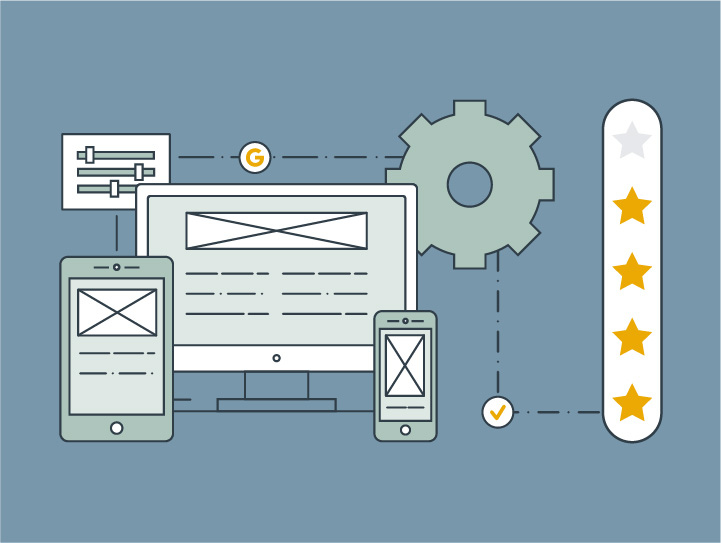Digital Marketing
Digital Expertise to Benefit Community Colleges

On May 28th, Google announced a major update to their search algorithm: website page experience will now be a ranking factor. With a new combination of Core Web Vitals and existing page experience data, the mysterious Google search algorithm is about to get a face lift. The message is clear: if your site gives visitors a poor experience, you’ll begin to rank lower in search results.
“Through both internal studies and industry research, users show they prefer sites with a great page experience. In recent years, Search has added a variety of user experience criteria, such as how quickly pages load and mobile-friendliness, as factors for ranking results.”
- Google Webmaster Central Blog
—,
So, how can you make sure you’re delivering a great page experience? Here’s what two of our TrendyMinds web experts think about this update, how brands can prepare, and what this all means for the future of web development.
Jon Immel
Senior Vice President, Digital Strategy
Jon leads the web service line at TrendyMinds, informed by his 16 years of crafting interactive experiences for high-profile websites.
Mitch Barnhill
Executive Director, Marketing
With six years of digital marketing experience, Mitch leads the TrendyMinds team on brand strategy, digital advertising, SEO, social media, and content marketing efforts.
Jon: I’m impressed that they’re building new ways for user experience to impact SEO. In the past, rankings were more about technical setup — things like metadata schemas and accessible site crawlers and bots. We’ve all had frustrating experiences on websites, and we’ve all had great experiences on websites, too. It’s exciting to see Google rewarding the sites that deliver great user experiences.
Mitch: Google understands deeply engaging sites are more meaningful to their users, and they want to reward those sites in the search results. I find it fascinating that they are calling so much attention to this indicator, but it’s important to remember that foundational elements of SEO will still require attention. HTTPS security, safe browsing, and mobile-friendliness are all still major ranking factors — and there are many others as well.
Mitch: Core Web Vitals are essentially Google’s outline of factors that impact search ranking. By following them, you’ll help give your visitors the best possible web experience, and also hopefully rank high in searches.
There are three Core Web Vitals categories:

Largest Contentful Paint (LCP)
Measures loading performance. To provide the best user experience, LCP should occur within 2.5 seconds of when the page first starts loading.
First Input Delay (FID)
Measures interactivity. To provide a good user experience, pages should have a FID of less than 100 milliseconds.
Cumulative Layout Shift (CLS):
Measures visual stability. To provide a good user experience, pages should maintain a CLS of less than 0.1.
By adding page experience to Core Web Vitals, and existing search signals. Google is giving us an increasingly dynamic reference source for creating web pages that perform well, deliver great experiences, and rank high.
Jon: LCP and FID have been part of Google tools like Page Speed Insights and Lighthouse for a while now — but the new addition of CLS is very interesting, and has the potential to impact a number of industries.
Media and ecommerce sites with heavy banner ads may need to shift their layouts. Essentially, any site with a lot of third-party code will end up with a lower CLS score. Everyone should be wary of integrating too many third-party tools.
Mitch: Your landing page is vitally important. It’s the hub for all your digital advertising activities, and it informs advertisers about content relevance and ad efficiency.
Google has four guidelines for improving page experiences:
If people are clicking on your ads and your site doesn’t live up to their expectations, Google won’t want to send them to you anymore. Great experiences are essential.
Jon: You can use Google’s PageSpeed Insights to see how your site scores for LCP, FID, and CLS. Sites with low scores often have poor image formatting — the wrong formats, file sizes, display sizes, lack of a content delivery network, or deferred offscreen image loading.
Third-party tools are also often to blame for low scores, and there isn’t much you can do to improve how they impact your site.
It’s worth reassessing whether the value you get from those tools is worth the performance hit — and there are lots of alternatives out there that may achieve similar results without affecting your SEO scores. Keep in mind that there may be no clear right or wrong answer. Sometimes, the performance hit is worth the value the third-party tool brings.
Mitch: There are lots of SEO and site performance tools marketers can use to check and improve their page experiences. Here are some of my favorites:
Jon: Google’s own tools are a great place to start, but there are some others we use a lot, too. Here are my favorites:
Google wants to give users the best possible experiences, so they keep using Google Search. Now that the technology exists to measure page experience, it’s only logical that Google would want this to be a factor in search results.
There’s still plenty of time to prepare pages for the algorithm update — but doing so as soon as possible will generate the most value for brands and customers alike. If you have any questions about how to improve your website in preparation for Google’s algorithm update, contact us at TrendyMinds. We can help you quickly put your website on track for fast performance, great page experience, and high SEO ranking.